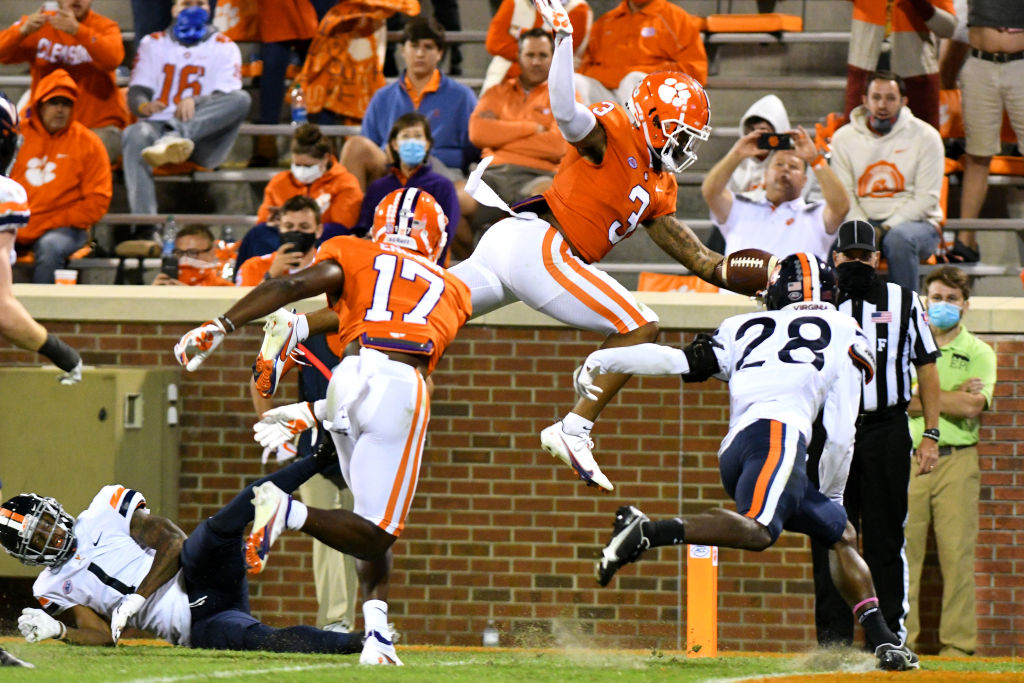Superficially, the Panthers’ need at receiver is very small, even though Curtis Samuel is expected to depart in free agency, as they have two 1,000 yard receivers from a year ago returning for 2021. However, while it seems extremely unlikely that DJ Moore and Robby Anderson won’t be the top two names on the depth chart come September (barring either being included in any trade for Deshaun Watson), the best receiver groups go a lot deeper than just the top two names.
While the Panthers do have some interesting depth options returning, including 2020 UDFA Omar Bayless, 2020 free agent signing Keith Kirkwood and former CFL start Brandon Zylstra, there is a real lack of proven quality outside of those first two options. With this in mind, while it won’t be at the top of their to-do list for the offseason, the Panthers should be looking to add to their existing receiver group this offseason, both through free agency and the draft.
If they take the latter approach, one name that has started to gain attention is that of Clemson receiver Amari Rodgers. So what does he show on tape and would he be a good fit in Carolina?
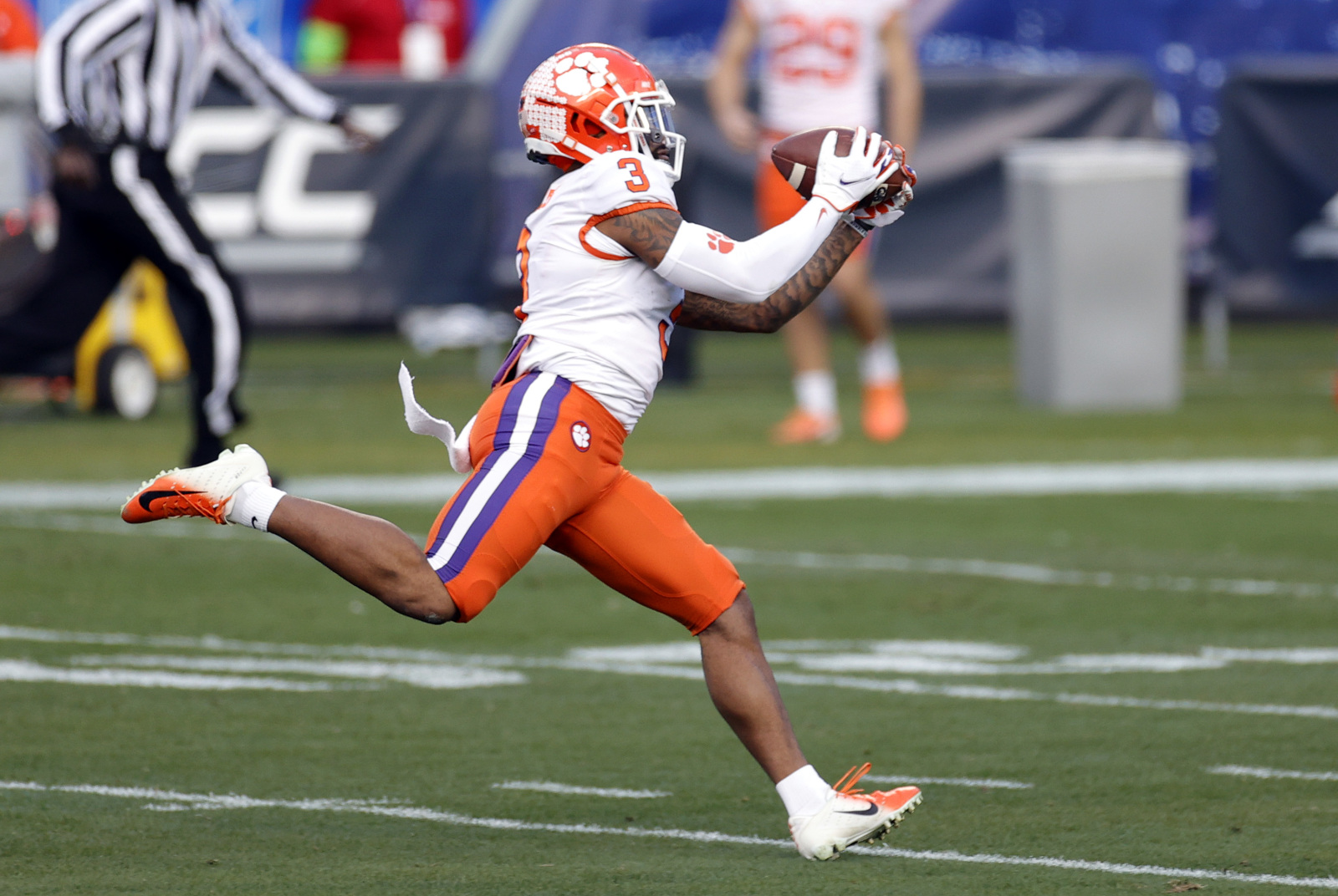
CHARLOTTE, NORTH CAROLINA – DECEMBER 19: Wide receiver Amari Rodgers #3 of the Clemson Tigers catches a 67-yard touchdown pass in the first quarter against the Notre Dame Fighting Irish during the ACC Championship game at Bank of America Stadium on December 19, 2020 in Charlotte, North Carolina. (Photo by Jared C. Tilton/Getty Images)
While his vertical speed is not his major selling point, Rodgers certainly shows an ability to get deep on tape and should be able to generate big plays down the field if allowed to run vertically without help over the to (please note that Rodgers wears #3 and predominantly lines up in the slot):
While Clemson didn’t ask him to run vertical a huge amount, he got a chance to show this ability more at the Senior Bowl, even if the pass wasn’t always where it needed to be:
On this play, he actually gets too much vertical separation early and has to decelerate to allow the corner to catch up so that he isn’t able to undercut the route when Rodgers breaks outside, but if they had been a simple go route he could likely have crossed into the endzone with several yards of separation.
The other impact of this speed is that it allows him to create separation running across the field, and this is something the Panthers have done a lot with Curtis Samuel in recent seasons so should translate well not just to the NFL but to the Panthers’ offense specifically:
In terms of core traits, he also shows good hands, with the ability to make catches away from his frame and to adjust to balls in the air:
He also shows the body control to make catches close to the boundary while ensuring to keep his feet in-bounds:
And also does well to hold onto the ball on routes over the middle even when contact is coming from behind him:
Though there were a couple of times on tape where the defender was able to knock the ball loose from his hands as he brought the ball back to his body:
And while this shouldn’t be a shock given his 5’10 stature, he is also not going to make a name for himself going up and making catches over defenders at the catch point, though he is not completely without value in this regard:
In terms of core natural traits then, Rodgers has the quickness, speed and hands that teams look for in NFL receivers. However, while all that is good, in order to create consistent value at the NFL level, a prospect has to offer more than just traits, so what does Rodgers offer that is more than just core traits?
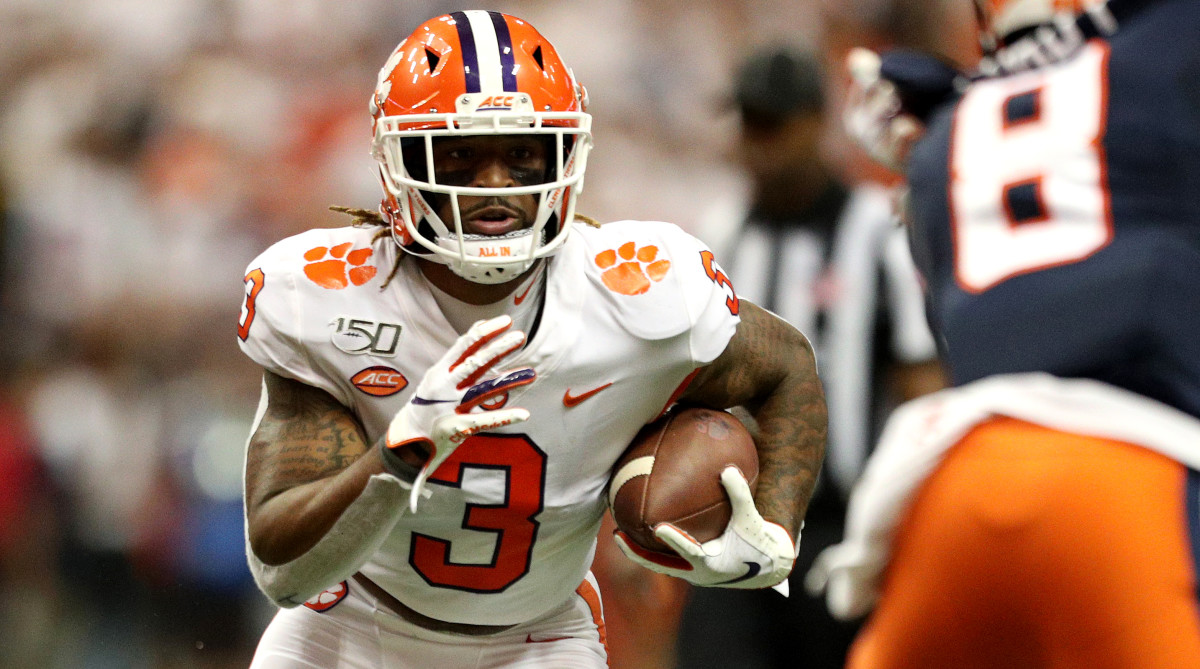
Photo Credit: Bryan M. Bennett/Getty Images
Rodgers didn’t run the full route tree at Clemson, as most college receivers don’t, and there are definitely areas of what he will likely be asked to do at the NFL level where he will likely need a little development. What he was asked to do a lot, both at Clemson and at the Senior Bowl, was to create separation at the head of routes, and this is something that he did to a really high level.
Before looking at how he did this in more detail, it is worth going back to a point about Rodger’s athleticism, as he is not only fast but really quick as well, and this means that if he is able to make the route a footrace between him and a defensive back starting from a stationary starting point, he is almost certainly going to win:
And this means at times he could create separation just by stopping at the head of the route and then reaccelerating, without having to consciously create directional leverage:
This is all good and well, but at the NFL level the athletes are likely going to be better, and this means that he will need to show a little more from a technique perspective than he did on this particular Senior Bowl rep. While this was not a constant feature of tape, this is something he does show the ability to do, with possibly the best example coming on this rep from the Senior Bowl:
Here, he is running an in-breaking route, but rather than running vertically to the head of the route and then breaking inwards, he stops just short of the head of the route and then reaccelerates. This forces the defender to stop his feet and then transition vertically, and when he does this he naturally loads weight onto his inside leg, making it harder for him to drive off it to counter the inside break that then follows.
Routes that effective have two heads are extremely difficulty for defensive backs, as the first head often puts them in a bad position to react to the second, and what Rodgers does here by creating such a route from one that likely on paper only has one is really valuable. If he is able to apply this to a wider variety of routes then he will give himself a chance to create consistent underneath separation, something that is extremely valuable, especially when paired with receivers that can stretch the field vertically such as those the Panthers already have.
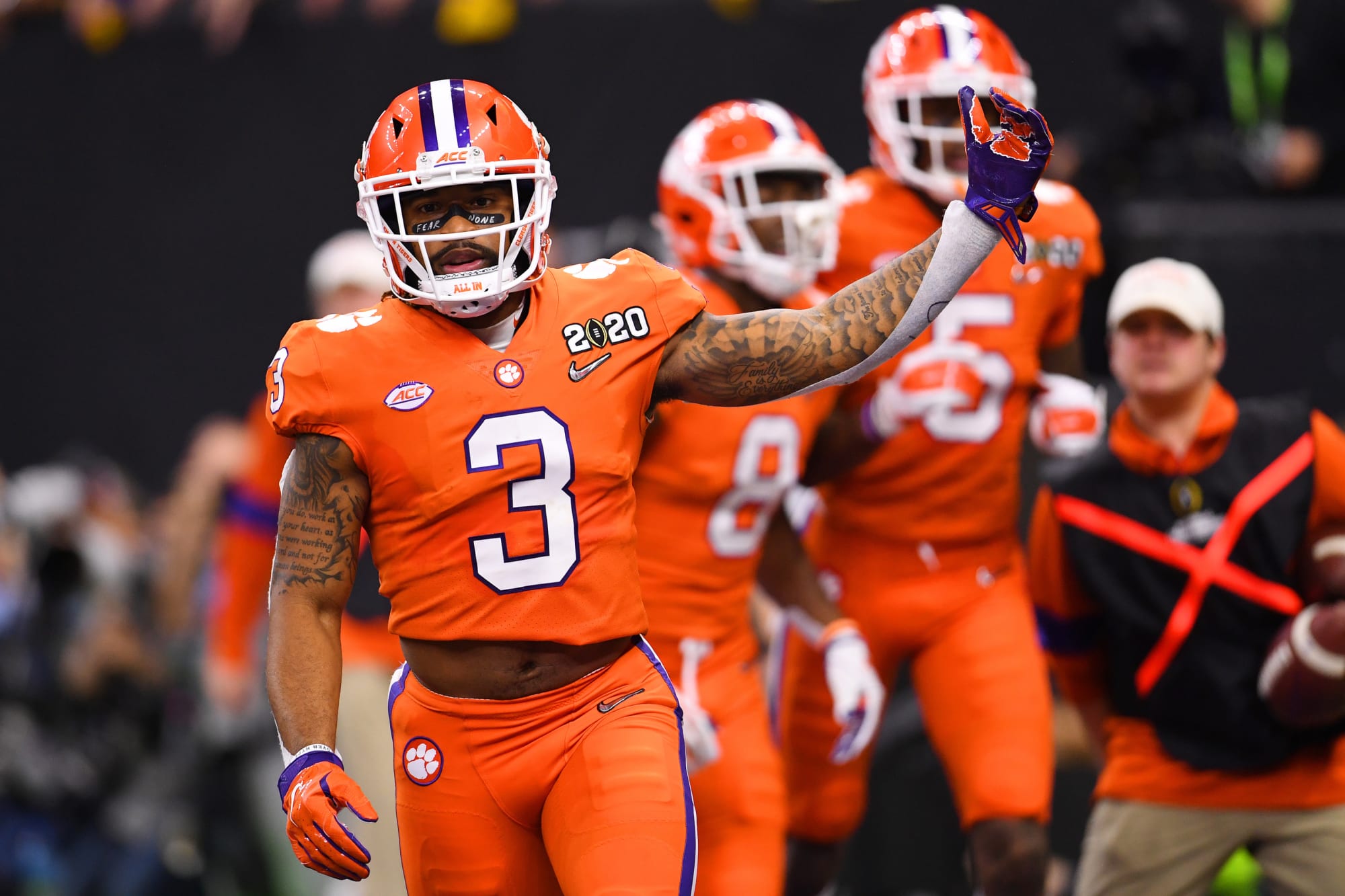
Photo Credit: Jamie Schwaberow/Getty Images
There are also a couple of things to like about his route running beyond this. Firstly, and related to the ability at the head of routes, is that he shows an understanding of how to set up his releases from routes using changes of speed. Here, the outside receiver is going to pick his man for him, but what he has to do is ensure that his man is in place to get picked. If he runs this route too quickly then the defensive back may be able to go over the pick without having to loop around. Instead, he is slow to the head of the route, allowing the pick to develop, and then accelerates towards the sideline:
Little subtleties like this are nice to see for themselves, but they also indicate an understanding of what routes are trying to accomplish that is only going to serve him well at the NFL level. The second thing he does well is that he does a nice job of creating space on scramble drills and after his initial route’s window has passed. Here, he initially looks to roll back behind the defender but then breaks back outside when he feels the defender taking away that inside leverage:
Things like this don’t make a receiver, but they all add up and add value.
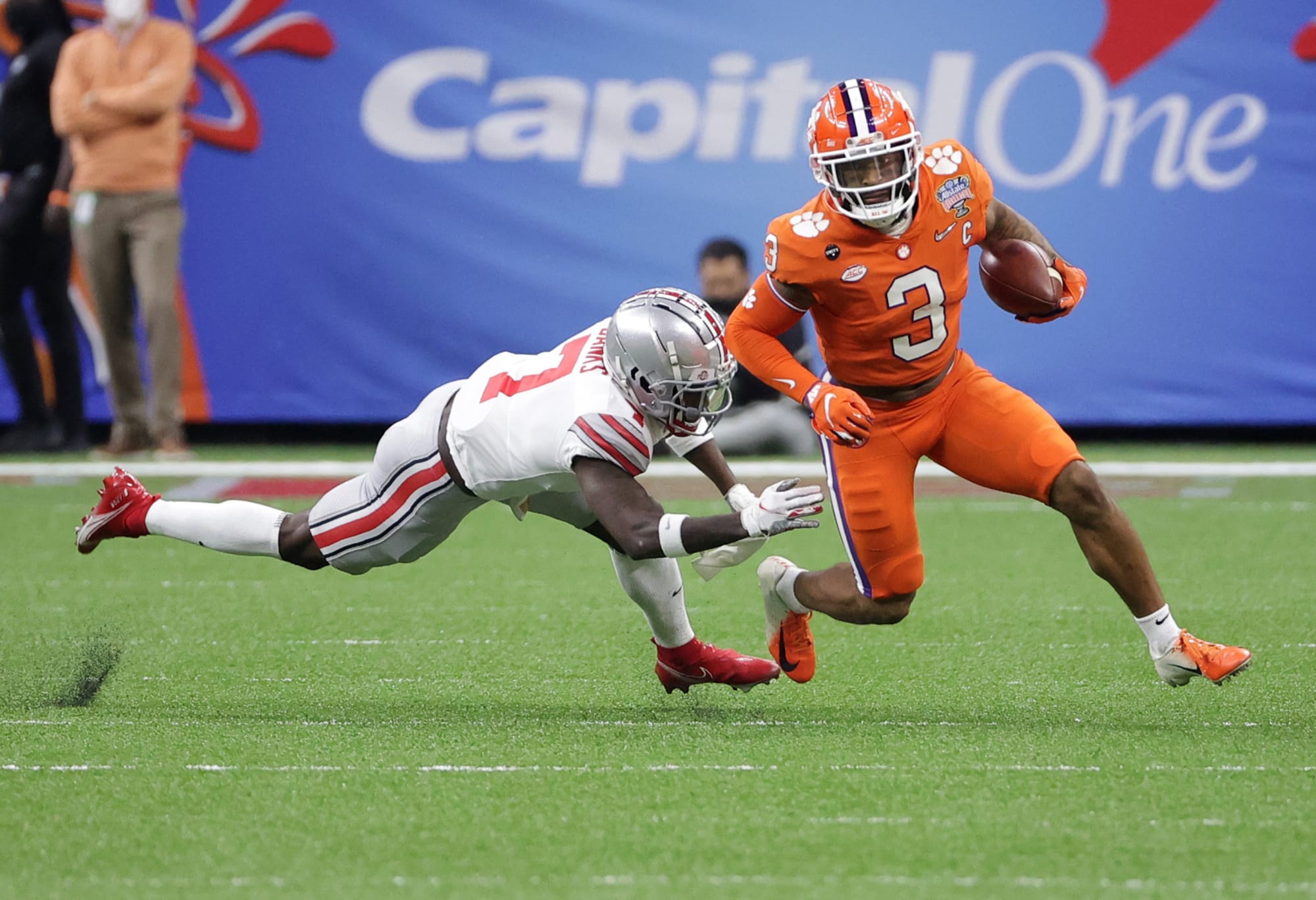
Photo Credit: Chuck Cook-USA TODAY Sports
There is, however, room for further improvement, and this largely comes on more vertical routes where the aim is to carry speed through a vertical cut, and given that this was really not a big part of what he was asked to do at Clemson the fact that he isn’t as strong in this regard as others isn’t surprising. A simple example is this slant, and while this is not a bad route he could take it to another level:
The issue here is that there isn’t that much space for him to run into before he encounters another defender, and while a slightly earlier throw would have made this an easier catch-and-run, the key is to create as much of a time window after the break to make the reception. While he does a reasonable job of this with the hesitation, if he had run harder at the outside shoulder of the defender then he would have stood a better chance of forcing him into his transition to respect the vertical and outside threat, and so created more separation when he then breaks across the face of the defender.
A slightly more complete example is given by this rep from the Senior Bowl:
Now this isn’t a route that Rodgers ran a lot in college, and it’s hard to know exactly how the Panthers’ staff were coaching him to run it at the Senior Bowl, but it would have been nice to see him really push the defender vertically here. He does well to win inside quickly with his release and has a step on the defender before looking to decelerate slightly and then stutters into the outside break.
Given that he does have really very good vertical speed, it would have been nice to see him really push this route vertically after the release and then rather than trying to lose the defender with the hesitation and stutter, just simply run him out of the route with his ability to carry that speed through the break. Against the very fastest defensive backs his ability to create separation at the head of routes will come back into play, but here, where he has a clear speed advantage, it would be nice to see him use that to greater effect.
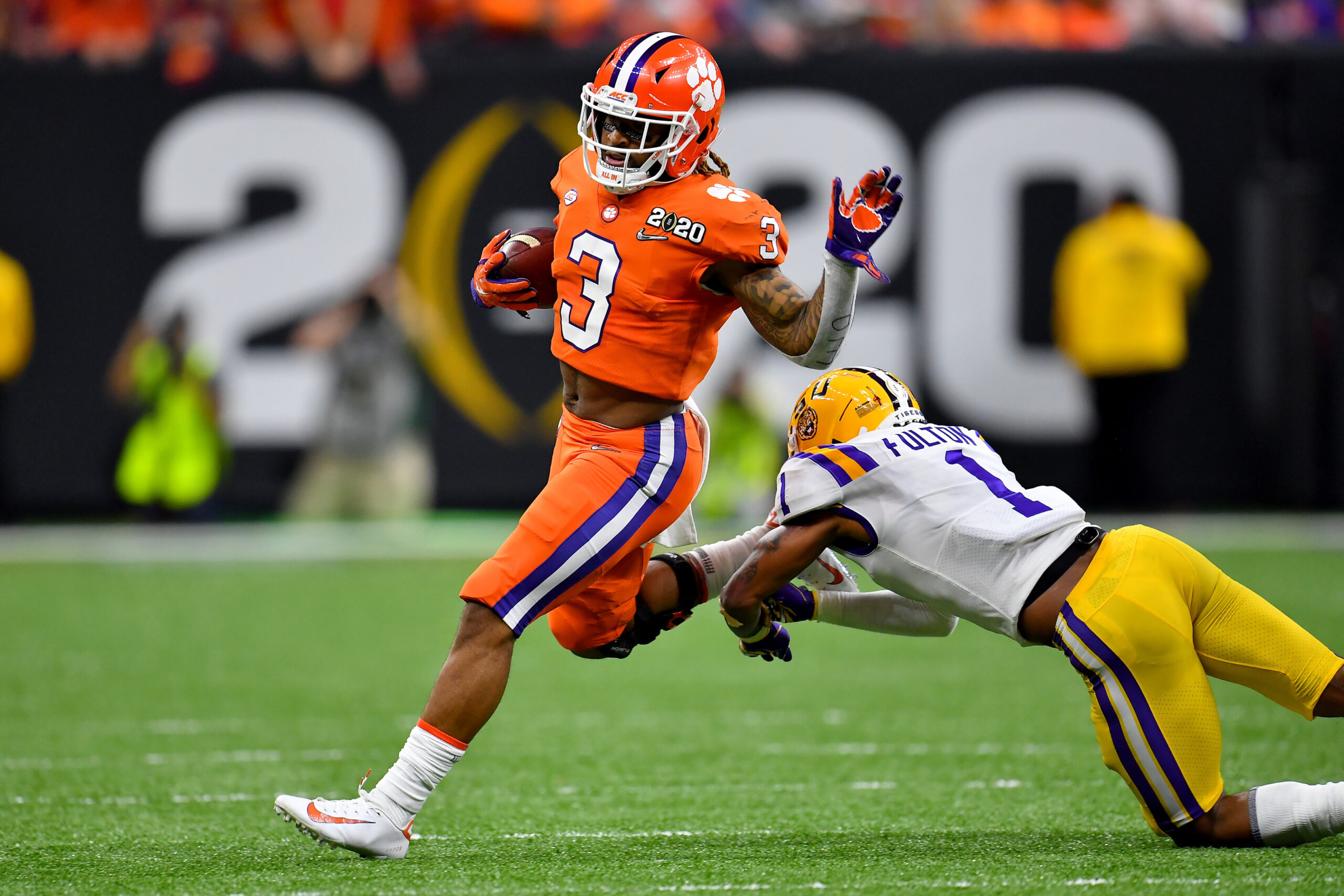
NEW ORLEANS, LOUISIANA – JANUARY 13: Amari Rodgers #3 of the Clemson Tigers breaks Kristian Fulton #1 of the LSU Tigers tackle during the second quarter of the College Football Playoff National Championship game at the Mercedes Benz Superdome on January 13, 2020 in New Orleans, Louisiana. The LSU Tigers topped the Clemson Tigers, 42-25. (Photo by Alika Jenner/Getty Images)
There critiques might seem liking picking holes, but what this is meant to indicate is that as good as Rodgers was at running the route tree he did at Clemson, there is the talent to be a really dangerous receiver over a more diverse route tree at the NFL level if he is able to combine his subtle changes of speed and direction at the head of routes with a willingness to really back his speed to threaten defenders vertically.
There is something to point out positively from some of these reps as well, especially from the Senior Bowl, as while Rodgers didn’t face a huge amount of press coverage in college, this is something he is likely to encounter at times in the NFL, especially if he spends some time playing outside as well as in the slot. What he did show on a fairly consistent basis during these reps at the Senior Bowl was tight footwork at the line to generate early leverage which he could then exploit with his quickness:
While this is a repertoire that he will have to add to if he is to spend a lot of time playing outside against press in the NFL, there is certainly enough there to be encouraged about his potential to play a meaningful role on the outside despite his superficial height limitations. With that said, there were a few times on tape where defenders were able to drive him off his route with physicality, and while every receiver is vulnerable to this at some level, this is something to watch out for with Rodgers:
And while on this route the defender should probably have been flagged for a hold, it would have been nice to see him do a better job of fighting through that contact:
This is really a minor quibble, and there are certainly other top receivers in this class who are just as vulnerable to defenders getting a bit physical, if not more so, but adding a greater level of physicality to his game would likely be to his benefit.
While his potential as a route runner is certainly extremely appealing, there is also another aspect to his game that we haven’t got to yet. What he can do after the catch.
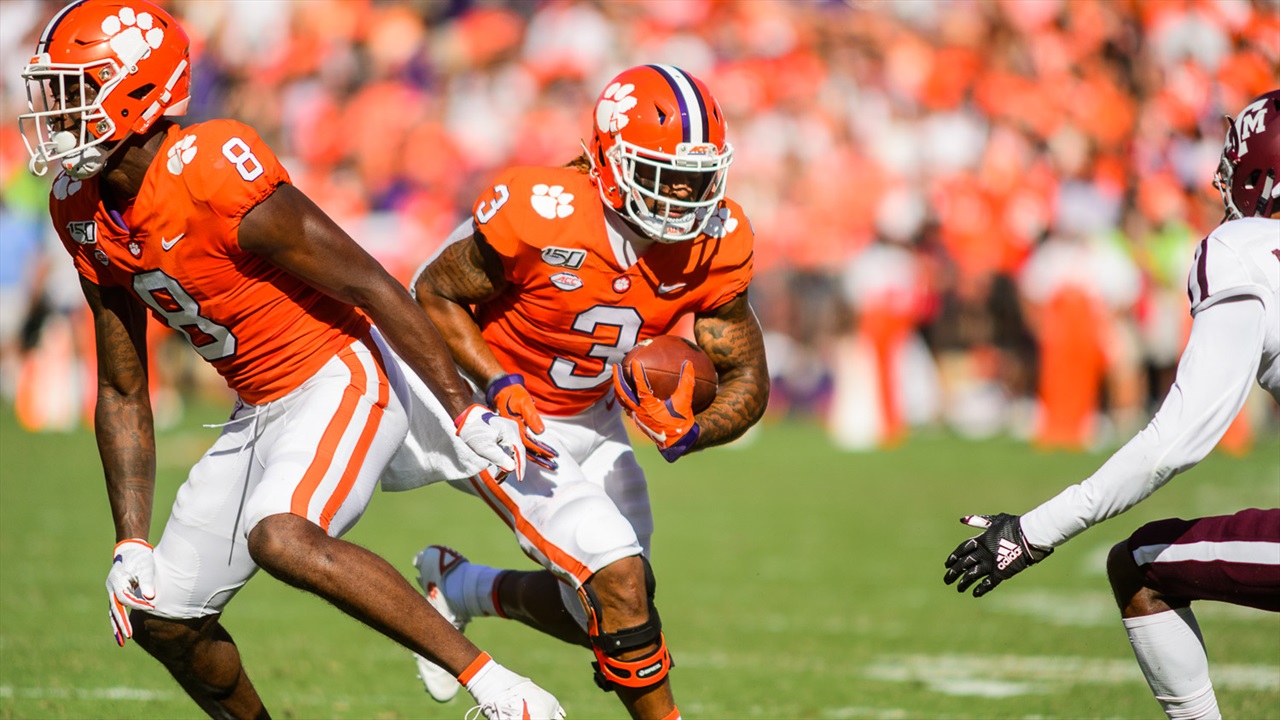
Photo Credit: Clemson Sports Talk
While he might not break a ton of tackles or juke many defenders out of their skins, Amari Rodgers is very good with the ball in his hands:
And while a lot of this has to do with balance, agility, vision and quickness, it is really hard not to notice what an excellent job he does of transitioning from catch to run:
As he’s making the catch, he looks to back away slightly from defenders to give himself that extra bit of space and then immediately is able to reset his feet and run downhill. This might not look very flashy, but it’s really impressive and allows him to turn fairly unremarkable short receptions into big plays:
Combined with this ability to create separation underneath at the head of the routes, this makes him a great fit as a slot possession receiver who also has the ability to attack the field vertically at times to prevent defenses from honing in on him underneath.
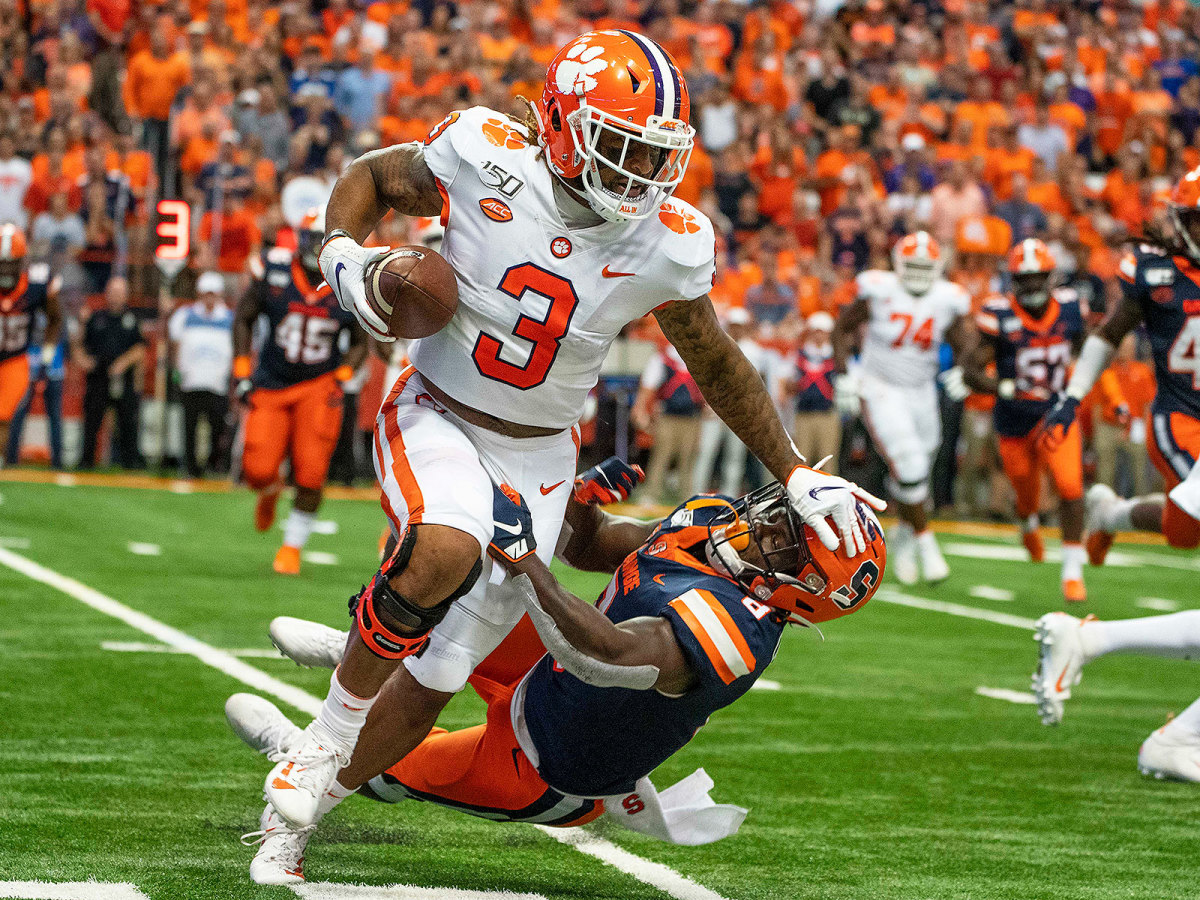
Photo Credit: Gregory Fisher/Icon Sportswire/Getty Images
While Rodgers really wasn’t asked to block very much in Clemson’s offense, it is worth noting that he actually shows really good blocking technique on the whole, generally setting a solid base and keeping his elbows narrow with a good direct punch:
Though he did have one pretty impressive whiff:
Again, this is a little detail, but these little details really add up, especially for a player who is expected to be draft either late on day two or early on day three and who is unlikely to walk into a starring role from day one.
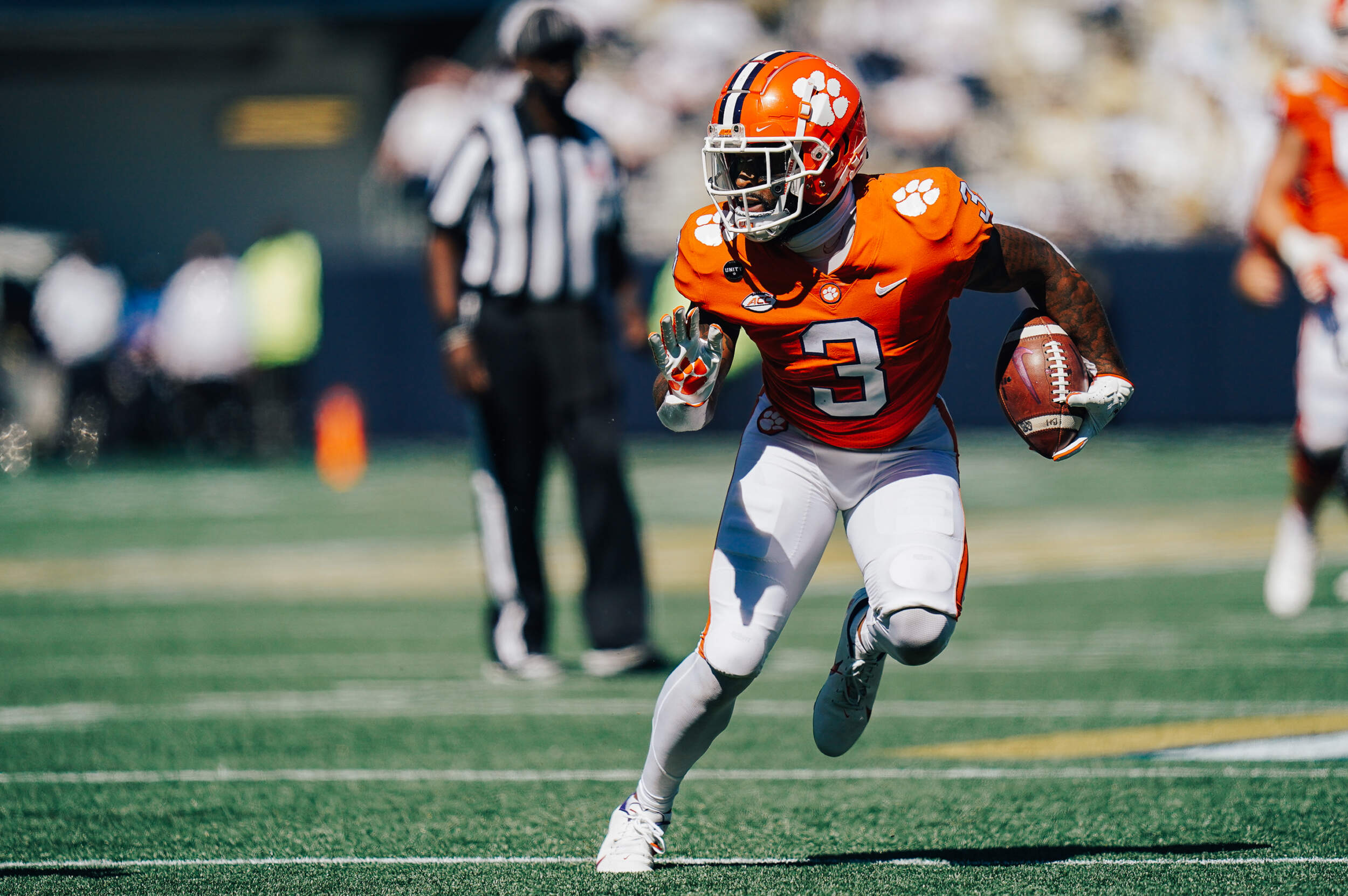
Photo Credit: David Platt/ABC Columbia
There are definitely areas that Rodgers will need to work on when he gets to the NFL, and as with most college receivers he will need to show that he can apply the same level of route running nuance to a complete NFL route tree as he did to the more limited tree he ran in college. However, not only does Rodgers flash great potential in terms of hands and athletic traits but also a consistent high level of route running over the route tree he did run, especially in terms of his ability to generate underneath separation at the head of routes.
For the Panthers, Rodgers would be a great fit, both in terms of the value he represents at the stage of the draft where the Panthers are likely to start seriously considering drafting a receiver, but also because of how he would fit with the other receivers already on the roster. Adding a player who is able to separate underneath against man coverage on a consistent basis will help the Panthers to move the chains more consistently and would also allow Moore and Anderson to spend more time doing what they do best and attacking a defense down the field.
It’s hard to single in on individual prospects this far out from the draft, and players have plenty of time to shoot up draft boards and go from potential steals to over-drafted, but it’s hard not to get at least a little excited about the prospect of Amari Rodgers in Carolina.
(Top photo via Icon Sportswire/Getty Images)

